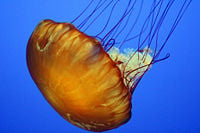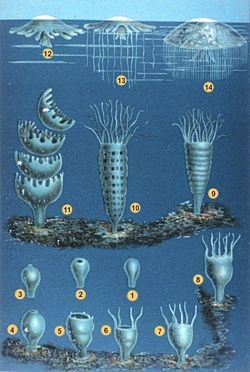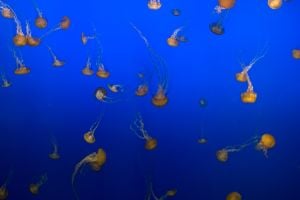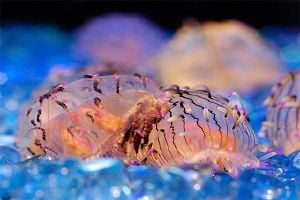Jellyfish
| Jellyfish | ||||||
|---|---|---|---|---|---|---|
 Sea nettle, Chrysaora quinquecirrha | ||||||
| Scientific classification | ||||||
| ||||||
| Orders | ||||||
|
Stauromedusae |
Jellyfish are marine invertebrates belonging to the Scyphozoan class of the Cnidaria phylum. The body of an adult jellyfish is composed of a bell-shaped, jellylike substance enclosing its internal structure, from which the creature's tentacles suspend.
Theoretically, members of Cnidaria have life cycles that alternate between asexual polyps (the body as a vase shaped form), and sexual, free-swimming forms called medusae (singular medusa; the body in a bell-shaped form). However, the Scyphozoa live most of their life cycle as medusa. The class name Scyphozoa means "cup animals," reflective of the dominant medusa form (Towle 1989). The term comes from the Greek word skyphos, denoting a kind of drinking cup.
The name of the plylum comes from cnidocytes, or nematocysts, which are specialized cells that carry stinging organelles. Each tentacle of a jellyfish is covered with these stinging cells, which can sting or kill other animals. Most jellyfish use them to secure prey or as a defense mechanism. Sea wasp jellyfish have killed dozens of people along the coast of Australia (Towle 1989). Some, such as Rhizostomae, do not have tentacles at all.
Jellyfish can be found in every ocean in the world. The size of the cups or bells can range from 2 centimeters across to 4 meters, and some speices trail tentacles for many meters below in the water (Towle 1989). Most jellyfish are passive drifters.
Since jellyfish do not biologically qualify as actual "fish", the term "jellyfish" is considered a misnomer by some, who instead employ the names "jellies" or "sea jellies". The name "jellyfish" is also often used to denote two other classes of cnidarians, Class Hydrozoa (Portuguese Man o' War, Obelia, etc.), or Class Cubozoa (box jellyfish or box jellies).
Life cycle and reproduction
Most jellyfish pass through two different body forms during their life cycle. The first is the polyp stage; in this phase, the jellyfish takes the form of either a sessile stalk which catches passing food, or a similar free-floating configuration. The polyp's mouth and tentacles are located anteriorly, facing upwards.
In the second stage, the jellyfish is known as a medusa. Medusae have a radially symmetric, umbrella-shaped body called a bell. The medusa's tentacles hang from the border of the bell.
Jellyfish are dioecious; that is, they are either male or female. In most cases, to reproduce, a male releases his sperm into the surrounding water. The sperm then swims into the mouth of the female jelly, allowing the fertilization process of the ova to begin. Moon jellies, however, use a different process: their eggs become lodged in pits on the oral arms, which form a temporary brood chamber to accommodate fertilization.
After fertilization and initial growth, a larval form, called the planula, develops from the egg. The planula larva is small and covered with cilia. It develops into a polyp, which again, can be sessile or free-floating depending on the species. The polyp tends to be cup-shaped with tentacles surrounding a single orifice, perhaps resembling a tiny sea anemone.
The polyp may reproduce asexually by budding, the splitting off from the parent organism to form a new organism. In this case, the polyp is called a segmenting polyp, or a scyphistoma. The polyp grows to become a young, and then an adult, medusa.
Many jellyfish can bud off new medusae directly from the medusan stage.
Defense and feeding mechanisms
Most jellyfish are passive drifters that feed on small fish and zooplankton that become caught in their tentacles. The tentacles or oral arms are coated with thousands of microscopic nematocysts. Generally, each of these nematocysts has a "trigger" (cnidocil) paired with a capsule containing a coiled stinging filament, as well as barbs on the exterior. Upon contact, the filament will swiftly unwind, launch into the target, and inject toxins. It can then pull the victim into its mouth, if appropriate.
Although most jellyfish are not perniciously dangerous to humans, a few are highly toxic, such as Cyanea capillata. The recently discovered Carukia barnesi is also suspected of causing two deaths in Australia.
Contrary to popular belief, the menacingly infamous Portuguese Man o' War (Physalia) is not actually a jellyfish, but a cnidarian colony of hydrozoan polyps (Class Hydrozoa).
Body systems
In its adult form, jellyfish are composed of 94–98% water.
To compensate for its lack of basic sensory organs and a brain, the jellyfish exploits its nervous system and rhopalia to perceive stimuli, such as light or odor, and orchestrate expedient responses. Jellyfish can detect the touch of other animals using a nervous system called a nerve net, which is found in its epidermis. Impulses to the nerve cells are sent from nerve rings that have collected information from the environment of the jellyfish through the rhopalial lappet, which is located around the animal's body. Jellyfish also have ocelli that cannot form images, but are sensitive to light. The jellyfish can use these to determine up from down, seemingly basing its judgement on the stimuli of sunlight shining on the surface of the water.
Jellyfish do not have a specialized digestive system, osmoregulatory system, central nervous system, respiratory system, or circulatory system. They do not need a respiratory system since their skin is thin enough that oxygen can easily diffuse in and out of their bodies.
Jellyfish have an incomplete digestive system, meaning that the same orifice is used for both food intake and waste expulsion. They are made up of a layer of epidermis, gastrodermis, and a thick jellylike layer called mesoglea that separates the epidermis from the gastrodermis. They are able to digest with the help of the gastrodermis that lines the gastrovascular cavity, where nutrients from their food is absorbed.
Jellyfish have limited control over their movement and mostly free-float, but can use a hydrostatic skeleton that controls the water pouch in their body to actuate vertical movement.
Their shape is not hydrodynamic, which makes them slow swimmers. But speed and low water resistance are not important as they are drifters that feed on plankton and food that passes nearby. It is more important for them that their movements create a current where the water (which contains their food) is being forced within reach of their tentacles. They accomplish this by having a body shaped like a bell, which is rhythmically opened and closed.
Blooms and grouping
A group of jellyfish is often called a "smack." Many species of jellyfish are also capable of congregating into large swarms or "blooms" consisting of hundreds or even thousands of individuals. The formation of these blooms is a complex process that depends on ocean currents, nutrients, temperature and oxygen content. Jellyfish will sometimes mass breed during blooms, jellyfish population and reportedly raising major ecological concern for a possible jellyfish outbreak.
According to Claudia Mills of the University of Washington, the frequency of these blooms may be attributed to mankind's impact on marine life; she says that the breeding jellyfish may merely be taking the place of already overfished creatures. Jellyfish researcher Marsh Youngbluth further clarifies that "jellyfish feed on the same kinds of prey as adult and young fishes, so if fish are removed from the equation, jellyfish are likely to move in."
Increased nutrient in the water, ascribed to agricultural runoff, has also been cited as an antecedent to the recent proliferation of jellyfish numbers: scientist Monty Graham says, "ecosystems in which there are high levels of nutrient ... provide nourishment for the small organisms on which jellyfish feed. In waters where there is eutrophication, low oxygen levels often result, favoring jellyfish as they thrive in less oxygen-rich water than fish can tolerate. The fact that jellyfish are increasing is a symptom of something happening in the ecosystem."
By sampling sea life in a heavily fished region off the coast of Namibia, researchers have found that jellyfish have actually overtaken fish in terms of the biomass they contribute to this ocean region. The findings represent a careful quantitative analysis of what's been called a "jellyfish explosion" after intense fishing in the area in the last few decades. The findings are reported by Andrew Brierley, of the University of St. Andrews, and his colleagues in the July 12, 2006 issue of the journal Current Biology.
Areas seriously affected by jellyfish blooms include the northern Gulf of Mexico, where "moon jellies have formed a kind of gelatinous net that stretches from end to end across the gulf," and the Adriatic Sea.[1] Some jellyfish have even been spotted along coastal shores.
Jellyfish in captivity
Jellyfish are commonly displayed in aquariums across the United States and in other countries; among the more known are the Monterey Bay Aquarium, Vancouver Aquarium, and Maui Ocean Center. Often the tank's background is blue with the animals illuminated by side lighting to produce a high contrast effect. In natural conditions, many of the jellies are so transparent that they can be almost impossible to see.
Holding jellies in captivity also presents other problems: for one, they are not adapted to closed spaces or areas with walls, which aquariums by definition have. They also depend on the natural currents of the ocean to transport them from place to place. To compensate for this, most professional exhibits feature water flow patterns. The Monterey Bay Aquarium uses a modified version of the "kreisel" (German for "spinning top") for this purpose.
Cuisine
Sliced and marinated jellyfish bells (often known as sesame jellyfish or jellyfish salad) is a common appetizer in Chinese cuisine. It is usually made using sesame seeds, sesame oil and, occasionally, spring onion. A similar dish appears in Vietnam, with red chilli pepper added. Korean version of the dish, haepari naengchae (cold jellyfish salad), is a summertime delicacy in the country, and is usually served with sweet and sour seasoning with mustard.
Packages of jellyfish bells (Chinese: 海蜇; pinyin: hǎizhé) can be bought at chinese grocery store in a salted and semi-desiccated form, which is usually yellow or slightly brownish in colour. The salted jellyfish does not have any fishy or unpleasant odours. It has been compared to the texture of elastic bands if dried.
Treatment of stings
When stung by a jellyfish, first aid may be in order. Though most jellyfish stings are not deadly, other stings, such as those perpetrated by the box jellyfish (Chironex fleckeri) may be fatal. Serious stings may cause anaphylaxis and eventual paralysis, and hence people stung by jellyfish must get out of the water to avoid drowning. In these serious cases, advanced professional care must be sought. This care may include administration of an antivenom and other supportive care such as required to treat the symptoms of anaphylactic shock.
There are three goals of first aid for uncomplicated jellyfish stings: prevent injury to rescuers, inactivate the nematocysts, and remove any tentacles stuck on the patient. To prevent injury to rescuers, barrier clothing should be worn. This protection may include anything from panty hose to wet suits to full-body sting-proof suits. Inactivating the nematocysts, or stinging cells, prevents further injection of venom into the patient.
Vinegar (3 to 10 % acetic acid in water) should be applied for box jellyfish stings.[1][2] However, vinegar is not recommended for Portuguese Man o' War stings.[1] In the case of stings on or around the eyes, vinegar may be placed on a towel and dabbed around the eyes, but not in them. Salt water (or fresh water if sea water is unavailable) may also be used in case vinegar is not readily available.[1][3] Rubbing the wound, or using alcohol, spirits, ammonia, or urine will encourage the release of venom and should be avoided.[4]
Once deactivated, the stinging cells must be removed. This can be accomplished by picking off tentacles left on the body.[4] First aid providers should be careful to use gloves or another readily available barrier device to prevent personal injury, and to follow standard universal precautions. After large pieces of the jellyfish are removed, shaving cream may be applied to the area and a knife edge, safety razor, or credit card may be used to take away any remaining nematocysts.[5]
Beyond initial first aid, antihistamines such as diphenhydramine (Benadryl) may be used to control skin irritation (pruritis).[5]
See also
- Sea nettle
- Irukandji jellyfish
- Moon jelly
- Phacellophora camtschatica
- Cubozoa (the box jellyfish)
- Physconect siphonophore
- Cassiopeas
- Physalia physalis, Portuguese Man O' War (not a true jellyfish)
- Cotylorrhiza tuberculata
- Rhizostoma pulmo (also known as the Rhizostoma octopus or white jellyfish)
- Pelagia noctiluca (jellyfish mainly found in British water and Mediterranean)
- Craspedacusta sowerbyi, freshwater "jellyfish" (not a true jellyfish)
- Lion's mane jellyfish, with the longest known tentacles (over 100 feet)
Footnotes
- ↑ 1.0 1.1 1.2 Fenner P, Williamson J, Burnett J, Rifkin J (1993). First aid treatment of jellyfish stings in Australia. Response to a newly differentiated species. Med J Aust 158 (7): 498-501. PMID 8469205.
- ↑ Currie B, Ho S, Alderslade P (1993). Box-jellyfish, Coca-Cola and old wine. Med J Aust 158 (12): 868. PMID 8100984.
- ↑ Yoshimoto C (2006). Jellyfish species distinction has treatment implications. Am Fam Physician 73 (3): 391. PMID 16477882.
- ↑ 4.0 4.1 Hartwick R, Callanan V, Williamson J (1980). Disarming the box-jellyfish: nematocyst inhibition in Chironex fleckeri. Med J Aust 1 (1): 15-20. PMID 6102347.
- ↑ 5.0 5.1 Perkins R, Morgan S (2004). Poisoning, envenomation, and trauma from marine creatures. Am Fam Physician 69 (4): 885-90. PMID 14989575.
External links
- Sea Science: Jellyfish
- Cotylorhiza tuberculata
- Treatment of Coelenterate and Jellyfish Envenomations
- British Marine Life Study Society - Jellyfish Page
- Jellyfish - Curious creatures of the sea
- Videos of Jellyfish
- Jellyfish Invasion Video
Credits
New World Encyclopedia writers and editors rewrote and completed the Wikipedia article in accordance with New World Encyclopedia standards. This article abides by terms of the Creative Commons CC-by-sa 3.0 License (CC-by-sa), which may be used and disseminated with proper attribution. Credit is due under the terms of this license that can reference both the New World Encyclopedia contributors and the selfless volunteer contributors of the Wikimedia Foundation. To cite this article click here for a list of acceptable citing formats.The history of earlier contributions by wikipedians is accessible to researchers here:
The history of this article since it was imported to New World Encyclopedia:
Note: Some restrictions may apply to use of individual images which are separately licensed.




